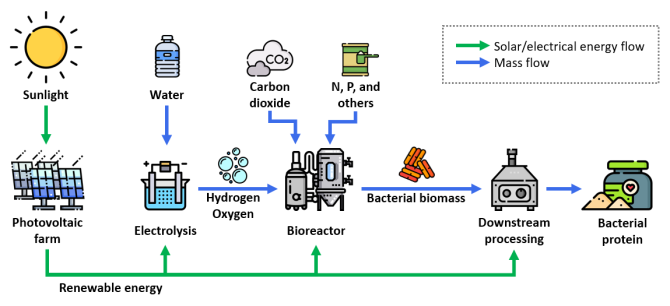
Project
Hydrogen gas fermentation as the future protein source
Hydrogen-oxidizing bacteria have a great potential to produce microbial protein for human consumption in a sustainable, efficient, and climate-resilient way. Several bioreactor design challenges need attention to realize this potential.
The problem
The currently ongoing climate crisis - especially caused by the carbon dioxide (CO2) and ammonia (NH3) emissions in combination with fast population growth - are endangering our food supply systems. Among all the responsible agents, agricultural practices have the biggest and most devastating impact on the environment. The main current protein sources are animal protein and plant protein, with soybean protein being the highest protein yielding crop. However, both of these protein sources carry entail several environmental challenges, such as the extensive land demand, deforestation problems, biodiversity loss, and low water and nitrogen use efficiency.
Microbial protein - also called single-cell protein (SCP) - is a much more sustainable and efficient way of producing protein. It has been shown that SCP production is much more efficient in nitrogen and water use, and productive per land area than traditionally efficient protein sources (e.g. up to 10 times more productive than soybean protein!). All this, while also capturing CO2 from the atmosphere. A specially promising group of organisms for SCP production are the Hydrogen-oxidizing bacteria, which are able to utilize hydrogen (H2) to fix CO2 into biomass with high protein content.
Despite the high potential of hydrogen-oxidizing bacteria for SCP production, there are multiple challenges related to the fermentation of gaseous substrates: mass transfer limitations, safety, energy consumption, scalability, etc.
Aim
This research will develop an innovative fermentation process to produce microbial protein using H2 and CO2 as main substrates.
Approach
With a focus on bioreactor design, some of the research challenges that need to be tackled are the following:
- What is the most suitable microbial metabolism within the hydrogen-oxidizing bacteria group?
- What bioreactor configuration enables the most efficient use of substrates?
- How to optimize the bioreactor operation to minimize production costs?
- What kind of system could be safe and minimize the risks associated to H2 reactivity?

At the end of this project, the devised technology has to be the safe, efficient, climate-resilient, and arable-land independent production system that we need in this climate changing world.